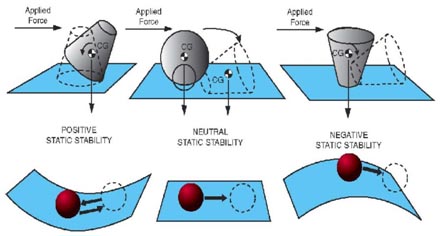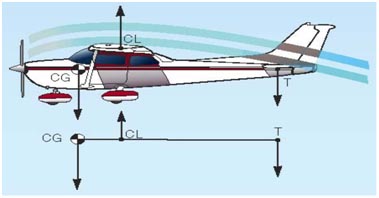 Download Tutorial Lengkap (PDF 237KB)
Download Tutorial Lengkap (PDF 237KB)
AIRCRAFT STABILITY
1. Stability Concept
The aircrafts response to momentary disturbance is associated with its inherent degree of stability built in by the designer, in each of the three axes, and occurring without any reaction from the pilot.

There is another condition affecting flight, which is the aircrafts state of trim or equilibrium (where the net sum of all forces equals zero). Some aircraft can be trimmed by the pilot to fly "hands off" for straight and level flight, for climb or for descent.
Free flight models generally have to rely on the state of trim built in by the designer and adjusted by the rigger, while the remote controlled models have some form of trim devices which are adjustable during the flight.
An aircrafts stability is expressed in relation to each axis:
1. lateral stability (stability in roll),
2. directional stability (stability in yaw)
3. Longitudinal stability (stability in pitch).
Lateral and directional stabilities are inter-dependent.
Stability may be defined as follows:
- Positive stability: tends to return to original condition after a disturbance.
- Negative stability: tends to increase the disturbance.
- Neutral stability: remains at the new condition.
2. Static vs. Dynamic Stability
- Static stability: refers to the aircrafts initial response to a disturbance. A statically unstable aircraft will uniformly depart from a condition of equilibrium.
- Dynamic stability: refers to the aircrafts ability to damp out oscillations, which depends on how fast or how slow it responds to a disturbance.
A dynamically unstable aircraft will (after a disturbance) start oscillating with increasing amplitude. A dynamically neutrally stable aircraft will continue oscillating after a disturbance but the amplitude of the oscillations will not change.
A statically stable aircraft may be dynamically unstable. Dynamic instability may be prevented by an even distribution of weight inside the fuselage, avoiding too much weight concentration at the extremities or at the CG. Also, control surfaces max throws may affect the flight stability, since a too much control throw may cause instability, e.g. Pilot Induced Oscillations (PIO).
Static stability is proportional to the stabilizer area and the tail moment. You get double static stability if you double the tail area or double the tail moment. Dynamic stability is also proportional to the stabilizer area but increases with the square of the tail moment, which means that you get four times the dynamic stability if you double the tail arm length.
However, making the tail arm longer or increasing the stabilizer area will move the mass of the aircraft towards the rear, which may also mean the need to make the nose longer in order to minimize the weight required to balance the aircraft.
A totally stable aircraft will return, more or less immediately, to its trimmed state without pilot intervention. However, such an aircraft is rare and not much desirable. We usually want an aircraft just to be reasonably stable so it is easy to fly. If it is too stable, it tends to be sluggish in maneuvering, exhibiting too slow response on the controls.
Too much instability is also an undesirable characteristic, except where an extremely maneuverable aircraft is needed and the instability can be continually corrected by on-board "fly-by-wire" computers rather than the pilot, such as a supersonic air superiority fighter.
3. Lateral & Longitudinal Stability
Lateral stability is achieved through dihedral, sweepback, keel effect and proper distribution of weight. The dihedral angle is the angle that each wing makes with the horizontal. If a disturbance causes one wing to drop, the lower wing will receive more lift and the aircraft will roll back into the horizontal level.
A sweptback wing is one in which the leading edge slopes backward. When a disturbance causes an aircraft with sweepback to slip or drop a wing, the low wing presents its leading edge at an angle more perpendicular to the relative airflow. As a result, the low wing acquires more lift and rises, restoring the aircraft to its original flight attitude.
The keel effect occurs with high wing aircraft. These are laterally stable simply because the wings are attached in a high position on the fuselage, making the fuselage behave like a keel. When the aircraft is disturbed and one wing dips, the fuselage weight acts like a pendulum returning the aircraft to the horizontal level.
The tail fin determines the directional stability. If a gust of wind strikes the aircraft from the right it will be in a slip and the fin will get an angle of attack causing the aircraft to yaw until the slip is eliminated.

Longitudinal stability depends on the location of the centre of gravity, the stabilizer area and how far the stabilizer is placed from the main wing. Most aircraft would be completely unstable without the horizontal stabilizer.
Non-symmetrical cambered airfoils have a higher lift coefficient, but they also have a negative pitching moment (Cm) tending to pitch nose-down and thus being statically unstable, which requires the counter moment produced by the horizontal stabilizer to get adequate longitudinal stability. The stabilizer provides the same function in longitudinal stability as the fin does in directional stability.
Symmetrical (zero camber) airfoils have normally a zero pitching moment, resulting in neutral stability, which means the aircraft goes wherever you point it. Reflexes airfoils (with trailing edge bent up) have a positive pitching moment making them naturally stable; they are often used with flying wings (without the horizontal stabilizer).
It is of crucial importance that the aircrafts Centre of Gravity (CG) is located at the right point, so that a stable and controllable flight can be achieved. In order to achieve a good longitudinal stability, the CG should be ahead of the Neutral Point (NP), which is the Aerodynamic Centre of the whole aircraft. NP is the position through which all the net lift increments act for a change in angle of attack. The major contributors are the main wing, stabilizer surfaces and fuselage.
The bigger the stabilizer area in relationship to the wing area and the longer the tail moment arm relative to the wing chord, the farther aft the NP will be and the farther aft the CG may be, provided its kept ahead of the NP for stability.
The angle of the fuselage to the direction of flight affects its drag, but has little effect on the pitch trim unless both the projected area of the fuselage and its angle to the direction of flight are quite large.
Selamat Terbang...